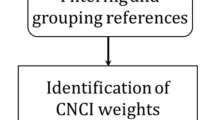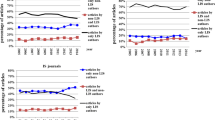Abstract
This study measured the proportion of articles by authors affiliated with library and information science (LIS)-related institutions and proportion of LIS authors in each journal using 3224 articles published in 75 journals in 2015 in the category of information science and library science as assigned by journal citation reports (JCR). Only 33.3% of journals published over half of their articles by LIS authors. Over half of authors affiliated with LIS institutions were identified in only 30.7% of journals. Library science-oriented journals had higher percentages of LIS authors and articles by LIS authors, followed by information science-oriented journals. Not all typical LIS journals were primarily contributed to by LIS authors. Additionally, 30 journals with a weak association to LIS research substantially explained the findings and tended to have higher impact factors. Lower ranks of typical LIS journals affect research rewards for LIS researchers when JCR impact factors are emphasized.

Similar content being viewed by others
References
Abramo, G., D’Angelo, C. A., & Di Costa, F. (2012). Identifying interdisciplinarity through the disciplinary classification of coauthors of scientific publications. Journal of the American Society for Information Science and Technology, 63(11), 2206–2222.
Abrizah, A., Noorhidawati, A., & Zainab, A. N. (2015). LIS journals categorization in the journal citation report: A stated preference study. Scientometrics, 102(2), 1083–1099.
Aharony, N. (2012). Library and information science research areas: A content analysis of articles from the top 10 journals 2007–8. Journal of Librarianship and Information Science, 44(1), 27–35.
Åströml, F. (2010). The visibility of information science and library science research in bibliometric mapping of the LIS field. Library Quarterly, 80(2), 143–159.
Bavdekar, S. B., & Save, S. (2015). Choosing the right journal for a scientific paper. Journal of Association of Physicians of India, 63, 56–59. http://japi.org/june_2015/09_aow_choosing_the_right.pdf.
Bornmann, L., & Daniel, H. D. (2008). What do citation counts measure? A review of studies on citing behavior. Journal of Documentation, 64(1), 45–80.
Butler, J. S., Kaye, I. D., Sebastian, A. S., Wagner, S. C., Morrissey, P. B., Schroeder, G. D., et al. (2017). The evolution of current research impact metrics. Clinical Spine Surgery, 30(5), 226–228.
Buttlar, L. (1999). Information sources in library and information science doctoral research. Library and Information Science Research, 21(2), 227–245.
Chang, Y. W. (2018a). Examining interdisciplinarity of library and information science (LIS) based on LIS articles contributed by non-LIS authors. Scientometrics, 116(3), 1589–1613.
Chang, Y. W. (2018b). Exploring the interdisciplinary characteristics of library and information science (LIS) from the perspective of interdisciplinary LIS authors. Library & Information Science Research, 40(2), 125–134.
Chang, Y. W., & Huang, M. H. (2012). A study of the evolution of interdisciplinarity in library and information science: Using three bibliometric methods. Journal of the American Society for Information Science and Technology, 63(1), 22–33.
Chen, C., Li, Q., Deng, Z., Chiu, K., & Wang, P. (2018). The preferences of Chinese LIS journal articles in citing works outside the discipline. Journal of Documentation, 74(1), 99–118.
Chou, C. P., Lin, H. F., & Chiu, Y. J. (2013). The impact of SSCI and SCI on Taiwan’s academy: An outcry for fair play. Asia Pacific Education Review, 14, 23–31. https://doi.org/10.1007/s12564-013-9245-1.
COPIOR. (2011). COPIOR journal list. Retrieved July 30, 2018, from http://www.copior.ac.uk/Journallist/tabid/158/Default.aspx.
Dorta-González, P., Dorta-González, M. I., Santos-Peñate, D. R., & Suárez-Vega, R. (2014). Journal topic citation potential and between-field comparisons: The topic normalized impact factor. Journal of Informetrics, 8(2), 406–418.
D’Souza, B., Kulkarni, S., & Cerejo, C. (2018). Authors’ perspectives on academic publishing: Initial observations from a largescale global survey. Science Editing, 5(1), 39–43.
Dyment, J. E., & Potter, T. G. (2015). Is outdoor education a discipline? Provocations and possibilities. Journal of Adventure Education and Outdoor Learning, 15(3), 193–208.
Glänzel, W., & Schubert, A. (2003). A new classification scheme of science fields and subfields designed for scientometric evaluation purposes. Scientometrics, 56(3), 357–367.
Gómez-Núñez, A. J., Batagelj, V., Vargas-Quesada, B., Moya-Anegón, F., & Chinchilla-Rodríguez, Z. (2014). Optimizing SCImago Journal & Country Rank classification by community detection. Journal of Informetrics, 8(2), 369–383.
Gómez-Núñez, A. J., Vargas-Quesada, B., & de Moya-Anegón, F. (2016). Updating the SCImago journal and country rank classification: A new approach using Ward’s clustering and alternative combination of citation measures. Journal of the Association for Information Science and Technology, 67(1), 178–190.
Gómez-Núñez, A. J., Vargas-Quesada, B., de Moya-Anegón, F., & Glänzel, W. (2011). Improving SCImago Journal & Country Rank (SJR) subject classification through reference analysis. Scientometrics, 89(3), 741–758.
Grzybowski, A. (2009). The journal impact factor: How to interpret its true value and importance. Medical Science Monitor, 15(2), SR1–SR4.
Hessey, R., & Willett, P. (2013). Quantifying the value of knowledge exports from librarianship and information science research. Journal of Information Science, 39(1), 141–150.
Huang, M. H., Wu, L. L., & Wu, Y. C. (2014). A study of research collaboration in the pre-web and post-web stages: A coauthorship analysis of the information systems discipline. Journal of the Association for Information Science and Technology, 66(4), 778–797.
Janssens, F., Zhang, L., de Moor, B., & Glanzel, W. (2009). Hybrid clustering for validation and improvement of subject-classification schemes. Information Processing and Management, 45, 683–702.
Leimu, R., & Koricheva, J. (2005). Does scientific collaboration increase the impact of ecological articles? Bioscience, 55(5), 438–443. http://www.bioone.org/doi/pdf/10.1641/0006-3568%282005%29055%5B0438%3ADSCITI%5D2.0.CO%3B2.
Levitt, J. M., Thelwall, M., & Oppenheim, C. (2011). Variations between subjects in the extent to which the social sciences have become more interdisciplinary. Journal of the American Society for Information Science and Technology, 62(6), 1118–1129.
Leydesdorff, L. (2006). Can scientific journals be classified in terms of aggregated journal–journal citation relations using the Journal Citation Reports? Journal of the American Society for Information Science and Technology, 57(5), 601–613.
Leydesdorff, L., & Rafols, I. (2009). A global map of science based on the ISI subject categories. Journal of the American Society for Information Science and Technology, 60(2), 348–362.
Lopatovska, I., & Ransom, E. (2016). The state of L-Schools: Intellectual diversity and faculty composition. Journal of Librarianship and Information Science, 48(1), 18–35.
Maier, G. (2006). Impact factors and peer judgment: The case of regional science journals. Scientometrics, 69(3), 651–667.
Meyer, T., & Spencer, J. (1996). A citation analysis study of library science: Who cites librarians? College and Research Libraries, 57(1), 23–33.
Ministry of Science and Technology. (2018). Journal evaluation and core journals list. Retrieved July 30, 2018, from http://www.hss.ntu.edu.tw/en/model.aspx?no=497.
Odell, J., & Gabbard, R. (2008). The interdisciplinary influence of library and information science 1996–2004: A journal-to-journal citation analysis. College and Research Libraries, 69(6), 546–565.
Ortega, L., & Antell, K. (2006). Tracking cross-disciplinary information use by author affiliation: Demonstration of a method. College & Research Libraries, 67(5), 446–462.
Paulus, F. M., Rademacher, L., Schäfer, T.A.J., Müller-Pinzler, L., & Krach, S. (2015). Journal impact factor shapes scientists’ reward signal in the prospect of publication. PLoS ONE, 10(11), e0142537. http://journals.plos.org/plosone/article/file?id=10.1371/journal.pone.0142537&type=printable.
Prebor, G. (2010). Analysis of the interdisciplinary nature of library and information science. Journal of Librarianship and Information Science, 42(4), 256–267.
Pudovkin, A. I., & Garfield, E. (2002). Algorithmic procedure for finding semantically related journals. Journal of the American Society for Information Science and Technology, 53(13), 1113–1119.
Qiu, L. (1992). A study of interdisciplinary research collaboration. Research Evaluation, 2(3), 169–175.
Rinia, E. J., van Leeuwen, T. N., Bruins, E. E. W., van Vuren, H. G., & van Raan, A. F. J. (2002). Measuring knowledge transfer between fields of science. Scientometrics, 54(3), 347–362.
Schummer, J. (2004). Multidisciplinarity, interdisciplinarity, and patterns of research collaboration in nanoscience and nanotechnology. Scientometrics, 59(3), 425–465.
Sedighi, M. (2013). Interdisciplinary relations in some high-priority fields of science and technology: An analytical study. Library Review, 62(6–7), 407–419.
Shao, J. F., & Shen, H. Y. (2012). Research assessment and monetary rewards: The overemphasized impact factor in China. Research Evaluation, 21(3), 199–203.
Shaw, W. C. (2016). Examining the classification problem of JCR from the perspective of academic evaluation: A case study of the category of the “information science and library science.” Unpublished Doctoral Dissertation, National Taiwan University, Taipei, Taiwan.
Shokraneh, F., Ilghami, R., Masoomi, R., & Amanollahi, A. (2012). How to select a journal to submit and publish your biomedical paper? BioImpacts, 2(1), 61–68. http://bi.tbzmed.ac.ir/Portals/0/BI-2012-2-1/Shokraneh-BioImpacts-2012-2-1.pdf.
Sivertsen, G. (2016). Patterns of internationalization and criteria for research assessment in the social sciences and humanities. Scientometrics, 107, 357–368.
Thijs, B., Zhang, L., & Glänzel, W. (2015). Bibliographic coupling and hierarchical clustering for the validation and improvement of subject-classification schemes. Scientometrics, 105(3), 1453–1467.
Urata, H. (1990). Information flows among academic disciplines in Japan. Scientometrics, 18(3–4), 309–319.
Walters, W. H., & Wilder, E. I. (2016). Disciplinary, national, and departmental contributions to the literature of library and information science, 2007–2012. Journal of the Association for Information Science and Technology, 67(6), 1487–1506.
Wang, F., & Wolfram, D. (2015). Assessment of journal similarity based on citing discipline analysis. Journal of the Association for Information Science and Technology, 66(6), 1189–1198.
Wang, Q., & Waltman, L. (2016). Large-scale analysis of the accuracy of the journal classification systems of Web of Science and Scopus. Journal of Informetrics, 10(2), 347–364.
Weech, T. L., & Pluzhenskaia, M. (2005). LIS education and multidisciplinarity: An exploratory study. Journal of Education for Library and Information Science, 46(2), 154–164.
Wijewickrema, M., & Petras, V. (2017). Journal selection criteria in an open access environment: A comparison between the medicine and social sciences. Learned Publishing, 30(4), 289–300.
Xu, F., Liu, W. B., & Mingers, J. (2015). New journal classification methods based on the global h-index. Information Processing and Management, 51, 50–61.
Zhang, L., Janssens, F., Liang, L., & Glänzel, W. (2010a). Journal cross-citation analysis for validation and improvement of journal-based subject classification in bibliometric research. Scientometrics, 82(3), 687–706.
Zhang, L., Liu, X., Janssens, F., Liang, L., & Glänzel, W. (2010b). Subject clustering analysis based on ISI category classification. Journal of Informetrics, 4(2), 185–193.
Zhang, L., Rousseau, R., & Glänzel, W. (2016). Diversity of references as an indicator of the interdisciplinarity of journals: Taking similarity between subject fields into account. Journal of the Association for Information Science and Technology, 67(5), 1257–1265.
Zhang, L., Sun, B. B., Chinchilla-Rodriguez, Z., Chen, L. X., & Huang, Y. (2018). Interdisciplinarity and collaboration: On the relationship between disciplinary diversity in departmental affiliations and reference lists. Scientometrics, 117(1), 271–291.
Acknowledgements
This work was financially supported by the Center for Research in Econometric Theory and Applications (Grant No. 108L900204) from The Featured Areas Research Center Program within the framework of the Higher Education Sprout Project by the Ministry of Education (MOE) in Taiwan, and by the Ministry of Science and Technology (MOST), Taiwan, under Grant No. MOST 108-3017-F-002-003.
Author information
Authors and Affiliations
Corresponding author
Rights and permissions
About this article
Cite this article
Chang, YW. Are articles in library and information science (LIS) journals primarily contributed to by LIS authors?. Scientometrics 121, 81–104 (2019). https://doi.org/10.1007/s11192-019-03186-w
Received:
Published:
Issue Date:
DOI: https://doi.org/10.1007/s11192-019-03186-w




